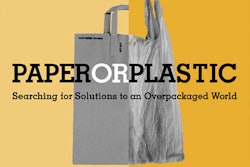Here are three key points to guide us as we develop sustainable packaging solutions.
1. It is an evolution. As part of a growing social and environmental responsibility, we must treat sustainable packaging as an evolution. Over the past 30 years, we've seen a number of drivers shape packaging responses. Some of the early drivers were product liability and product safety issues that drove business decisions on packaging such as security seals and tamper evidence. Then quality issues drove decisions. More recently, it's been government regulations and we entered the era of product stewardship.
Now, our goal has evolved to sustainability. It is a key factor that packagers can't ignore if they expect to be in business 10 years from now. The relationship of sustainability and survival is bolstered by the fact that companies listed on the Dow Jones Sustainability Index on average financially outperform companies that have not made the list.
2. It needs reliable data. Reliable data for decision-making is a must in attaining sustainability. Currently there is more opinion, misinformation and incorrect perceptions than real data on sustainability. It is the duty of the package engineer to go beyond presumption and “feel good” information to make decisions.
Tools are beginning to emerge that will aid the package designer in material selection as the drive for sustainability continues. The Paper Working Group supported by Metafore is nearing the release of “The Environmental Paper Assessment Tool”SM (EPAT). It establishes consistent language and metrics for environmentally preferable paper and facilitates communication between the buyers and suppliers of paper products.
The Institute of Packaging Professionals (IoPP) has published a guide and is developing a Certification Program for Environmental Packaging Design for the electronics industry. IoPP is working to identify individuals and companies interested in creating other packaging industry modules for this program.
Packaging life-cycle analysis tools that analyze the environmental impact of package materials, process, and designs from obtaining raw materials to processing to transportation to end of life are beginning to appear. The Sustainable Packaging Coalition is currently investigating such a tool. An excellent example of packaging life-cycle analysis was generated by the Center for Sustainable Systems, University of Michigan, for Stonyfield Farm and is available for review on the University of Michigan web site.
3. It doesn't need a regulatory straightjacket. Laws and regulations created with the best of intentions by some who are less informed than the packaging community are rapidly becoming a quagmire. The packaging take-back requirements in the EU vary broadly from country to country on reporting requirements, categorization of materials, and the fees per kilogram of material. Reporting and remittance frequencies are diverse as well.
With the addition of Quebec and Ontario to the mix, the complexity continues to grow. Several U.S. states are considering take-back legislation. We anticipate that within five to seven years, 80% of the markets we serve will have take-back programs of one kind or another.
Government regulations often set priorities that seem to achieve a goal but under critical investigation, don't. European “take-back” fees divert corporate resources into detailed compliance efforts. These resources could be devoted to finding better outcomes. “The European Standards in the field of packaging and packaging waste” will require increasing levels of support documentation to satisfy government and customer requests for proof that the standards are being met.
In order to add some consistency to what will be a continuing onslaught of packaging laws and regulations, it is the responsibility of packaging professionals and companies large and small to work together through industry trade groups to get ahead of the curve. Having shown due diligence in creating tools and processes to
support true and real sustainable packaging, we must guide local, state, and federal governments around the world as they create and modify packaging laws.
Sustainable packaging is not a marketing tool or a feel-good slogan of the year. It's a survival strategy.
About the author: IoPP member Randy Boeller is packaging engineering program manager for the HP Global Packaging Team and a leader in the company's drive toward sustainable packaging. For information about IoPP, visit www.iopp.org



























